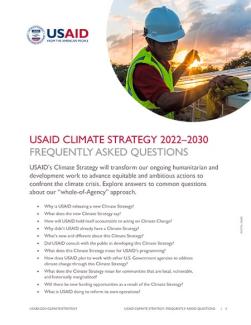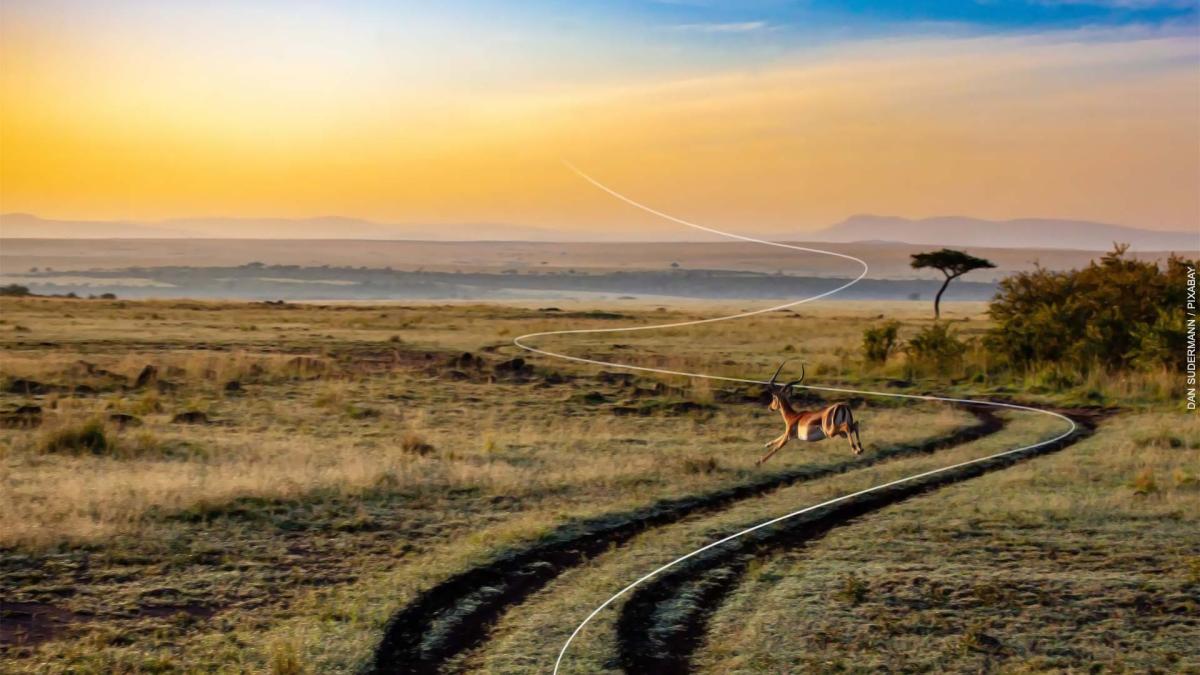- Why is USAID releasing a new Climate Strategy?
- What does the new Climate Strategy say?
- How will USAID hold itself accountable to acting on Climate Change?
- Why didn’t USAID already have a Climate Strategy?
- What’s new and different about this Climate Strategy?
- Did USAID consult with the public in developing this Climate Strategy?
- What does this Climate Strategy mean for USAIDʼs programming?
- How does USAID plan to work with other U.S. Government agencies to address climate change through this Climate Strategy?
- What does the Climate Strategy mean for communities that are local, vulnerable, and historically marginalized?
- Will there be new funding opportunities as a result of the Climate Strategy?
- What is USAID doing to reform its own operations?
Why is USAID releasing a new Climate Strategy?
The United States and the world face a profound climate crisis. Climate change is a cross-cutting issue that is already exacerbating global inequities, contributing to conflict, and increasing the need for humanitarian assistance. As Administrator Samantha Power has said, “The climate crisis threatens every inch of progress we make in efforts to build long-term prosperity and secure the individual dignity of the communities we serve.” USAID is already responding to the climate crisis as part of the Biden-Harris Administrationʼs bold climate agenda and implementation of the Paris Agreement by working with partner countries to implement climate solutions.
As part of President Bidenʼs Leadersʼ Summit on Climate in April 2021, USAID committed to developing a new Climate Strategy. The Strategy serves as a guide for the Agencyʼs efforts to target climate change resources strategically, ramp up climate change mitigation and adaptation efforts, and further integrate climate change considerations into international development and humanitarian assistance programs across all sectors.
What does the new Climate Strategy say?
USAID has developed a new Climate Strategy that will guide our work through 2030 in a way that is truly different: by calling on all corners of USAID to play a part in our “whole-of-Agency” response. Every USAID sector, Mission, and operating Unit—and all our partners—have a role to play as we work on the ground to set the global trajectory toward a resilient, prosperous, and equitable world with net-zero emissions.
Our Climate Strategy is guided by a single, overarching goal: to advance equitable and ambitious actions to confront the climate crisis. Our efforts to achieve this goal are organized around two main Strategic Objectives.
1. Targeted Direct Action. This Objective recognizes the need to prioritize and confront the most urgent demands of the climate crisis in the here and now. USAID will carefully target climate change mitigation and adaptation efforts to the highest priority communities and locations—those with the most urgent needs or most immediate opportunities—in order to maximize our impact and will place a special emphasis on mobilizing funds from both the public and private sectors to tackle the climate crisis.
2. Systems Change. This Objective acknowledges that fully addressing the climate crisis requires long-term, transformative changes that affect every aspect of society and will be neither easy no quick. USAID will take a systems approach to these larger transformations—such as transforming food systems to be more resilient, less wasteful, and less environmentally destructive, or transitioning economic systems to be less carbon-intensive—in ways that are comprehensive, equitable, and locally led.
These Objectives are not mutually exclusive, but rather mutually reinforcing. We will aim to achieve both in parallel or, at times, sequentially. Our Strategic Objectives are supported by a Special Objective to “Do Our Part.” We are working to transform our own workforce, operations, and policies to substantially reduce carbon emissions, adapt to the climate crisis, and further climate justice—and support and expect our implementing partners to do the same. This will include implementing sustainability improvements and strengthening the diversity, equity, inclusiveness, and accessibility of the climate workforce.
This Strategy is built on several foundational principles, which will be incorporated into all planning and activities:
- Support sustainable and equitable climate actions that are locally led, owned, and implemented and tailored and context appropriate.
- Center its actions in the context of the diverse communities in which we work, and engage local, marginalized, and underrepresented groups as agents of change.
- Partner with the private sector to expand the scale, impact, and sustainability of our programs
- Elevate nature-based solutions as key tools to absorb carbon, reduce disaster risk, support livelihoods, and improve food and water security.
- Support the rigorous research, technology and development needed to identify and deploy effective climate solutions, including those locally known and developed.
We encourage you to review the full Climate Strategy for additional context and detail.
How will USAID hold itself accountable to acting on Climate Change?
An Agency strategy, per USAID requirements (ADS 200), must include explicit targets to be achieved within a specific time period. This Climate Strategy includes six ambitious high-level targets that reflect how a whole-of-Agency approach can dramatically increase USAIDʼs impact. USAID will update and supplement these 2030 targets with interim targets throughout the Strategyʼs lifetime as our budget and experience with delivery evolves.
- Mitigation: USAID will partner with countries to support activities that reduce, avoid, or sequester six billion metric tons of carbon dioxide equivalent.
- Natural and Managed Ecosystems: USAID will support the conservation, restoration, or management of 100 million hectares with a climate change mitigation benefit.
- Adaptation: USAID will enable the improved climate resilience of 500 million people.
- Finance: USAID will mobilize $150 billion in public and private finance for climate.
- Country Support: USAID will align our development portfolios with countriesʼ climate change mitigation and adaptation commitments in at least 80 countries by 2024, and will support our partners to achieve systemic changes toward meeting those commitments in at least 40 countries.
- Critical Populations: USAID will support our partners to achieve systemic changes that increase meaningful participation and active leadership in climate action of Indigenous Peoples, local communities, women, youth, and other marginalized and/or underrepresented groups in at least 40 partner countries.
The Strategy also contains several requirements and suggested steps that Operating Units should take as they identify how they will contribute to Objectives, Intermediate Results, and Targets in strategic planning processes. These are designed to help us ramp up implementation as efficiently and effectively as possible. We will continue to integrate climate change into USAID policy, planning, programming, operations, and reporting, such as the forthcoming USAID Policy Framework, to ensure our climate work is coherent across USAID sectors.
Why didn’t USAID already have a Climate Strategy?
USAID developed its previous Climate Change Strategy in 2012, but it expired in 2018. Our new Climate Strategy, which runs from 2022 through 2030, builds on this foundation while significantly raising our ambition to meet the challenges posed by the climate crisis.
What’s new and different about this Climate Strategy?
USAID recognizes the need for urgent global action at an unprecedented scale. Whereas our previous strategy focused on specific climate mitigation and adaptation measures, this one recognizes the need to supplement our direct climate change work with an unprecedented “all hands on deck” approach that integrates climate action into all that we do.
We will also focus more on catalyzing change across complex systems, such as food, energy, financial, governance, and health, that will have impacts far beyond what can be achieved in a single sector. This Strategy also elevates a focus on equitable, inclusive action and partnership with key agents of change like local communities, Indigenous Peoples, women, youth, and persons with disabilities.
Did USAID consult with the public in developing this Climate Strategy?
This Strategy is the result of a robust internal and external engagement process. Through the development process, USAID held an extensive series of more than 40 listening sessions with internal and external stakeholders around the globe. These included current and former USAID staff in Washington and in the field, implementing partners, the international NGO community, the donor community, women, youth, Indigenous Peoples groups, and the private sector.
USAID held a public comment period from November 3–24, 2021, during which time we received and addressed more than 2,800 comments. We also held an internal comment period, where we received and addressed more than 1,000 comments.
What does this Climate Strategy mean for USAIDʼs programming?
USAID will coordinate internally to organize and galvanize a whole-of-Agency response to the climate crisis. The team coordinating USAIDʼs Climate Strategy implementation includes personnel from across all of USAIDʼs Bureaus and Independent Offices. We will continue working across U.S. Government departments and agencies, with Congress, with our partner governments, implementing partners, and with local organizations to identify how we can best target our work to achieve optimal climate and development objectives, both now and in the future.
USAID will develop and regularly update robust guidance for tracking our progress as we implement this Strategy. The Strategy also includes requirements and recommendations for all USAID Operating Units to facilitate implementation. To reduce inefficiencies and improve coherence across all programming, much of our implementation guidance integrates into existing processes, such as budget planning, workforce recruitment, and monitoring, evaluation, and learning, which are routine features of the USAID Program Cycle. We are dedicating resources to capacity building, knowledge management, and communications to support our whole-of-Agency approach to climate change.
How does USAID plan to work with other U.S. Government agencies to address climate change through this Climate Strategy?
USAIDʼs Strategy aligns with and supports broader U.S. Government efforts to tackle the climate crisis. USAID plays an essential role by working on the ground with partner countries and local actors to translate climate commitments into action and impact. We draw on our strengths as an international development agency, which include our global presence, longevity in many of our partner countries, breadth of technical and development expertise, and convening power.
USAIDʼ Strategy is closely aligned with broader U.S. Government strategic efforts, including climate and sustainability efforts, and will complement and reinforce the work of our interagency partners. For example, we are working with the Department of State on the Global Climate Ambition Initiative, supporting partner governments to make and achieve more ambitious climate plans and priorities. The Strategyʼs all-hands-on-deck approach will mean we are better able to fulfill the pledges in whole-of-government initiatives like the Presidentʼs Emergency Plan for Adaptation and Resilience (PREPARE) and Plan to Conserve Global Forests.
Climate change is also core to the USAID-State 2022–2026 Joint Strategic Plan. We are similarly coordinating with the Development Finance Corporation, Millennium Challenge Corporation, and agencies like the Departments of Treasury, Energy, Transportation, and Agriculture amongst others. We will continue to work with Congress to ensure we are maximizing USAIDʼs strategic impact. In drafting the Strategy, we also consulted with authors of other USAID strategies (like the U.S. Global Water Strategy and appended USAID Plan) to learn from them and better integrate climate considerations across USAID and USG strategies.
What does the Climate Strategy mean for communities that are local, vulnerable, and historically marginalized?
We know it is critical that our work reflects and elevates voices from the communities in which we work, including Indigenous Peoples, women and girls, youth, and others who face the brunt of the climate crisis, yet have limited access to or influence over decision-making. The Climate Strategy includes a target to support our partners to achieve systemic changes that increase meaningful participation and active leadership in climate action of Indigenous Peoples, local communities, women, youth, and other marginalized and/or underrepresented groups in at least 40 partner countries by 2030.
We will continue working to elevate communities in all their diversity, including within USAID, through USAIDʼs Diversity, Equity, and Inclusion Strategy. USAID will also take steps to ensure that climate change activities do not perpetuate inequality or cause or exacerbate stressors of conflict, corruption, or injustice.
Will there be new funding opportunities as a result of the Climate Strategy?
As we ramp up our climate change programming and incorporate climate action throughout USAIDʼs sectors and operations, we anticipate there will be new opportunities to partner with USAID to tackle the climate crisis. You can find out more about how to partner with us by visiting WorkwithUSAID.gov.
What is USAID doing to reform its own operations?
Through the Special Objective of USAID’s Climate Strategy to Do Our Part, USAID is reforming our operations by reducing our carbon footprint and strengthening diversity, equity, inclusion, and accessibility (DEIA) in our workforce, while encouraging our implementing partners to do the same.
In particular, USAID is baselining our carbon emissions footprint and sustainability performance, setting greenhouse gas emissions reduction targets, downsizing our office space and achieving LEED certified buildings, adopting electric and hybrid electric vehicles, reducing our travel, working toward net-zero emissions in Federal procurement, and working to use clean and renewable energy in our facilities, where possible based on country conditions, and in collaboration with the Department of State.
To learn more, check out USAID’s blog post about our operational sustainability efforts: https://medium.com/usaid-2030/doing-our-part-54ac6204a32




